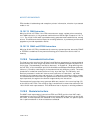
Vol. 3 19-23
ARCHITECTURE COMPATIBILITY
Following is an example code sequence to initialize the system and check for the
presence of Intel486 SX processor/Intel 487 SX math coprocessor.
fninit
fstcw mem_loc
mov ax, mem_loc
cmp ax, 037fh
jz Intel487_SX_Math_CoProcessor_present ;ax=037fh
jmp Intel486_SX_microprocessor_present ;ax=ffffh
If the Intel 487 SX math coprocessor is not present, the following code can be run to
set the CR0 register for the Intel486 SX processor.
mov eax, cr0
and eax, fffffffdh ;make MP=0
or eax, 0024h ;make EM=1, NE=1
mov cr0, eax
This initialization will cause any floating-point instruction to generate a device not
available exception (#NH), interrupt 7. The software emulation will then take control
to execute these instructions. This code is not required if an Intel
487 SX math
coprocessor is present in the system. In that case, the typical initialization routine for
the Intel486 SX microprocessor will be adequate.
Also, when designing an Intel486 SX processor based system with an Intel 487 SX
math coprocessor, timing loops should be independent of clock speed and clocks per
instruction. One way to attain this is to implement these loops in hardware and not in
software (for example, BIOS).
Table 19-3. EM and MP Flag Interpretation
EM MP Interpretation
0 0 Floating-point instructions are passed to FPU; WAIT/FWAIT
and other waiting-type instructions ignore TS.
0 1 Floating-point instructions are passed to FPU; WAIT/FWAIT
and other waiting-type instructions test TS.
1 0 Floating-point instructions trap to emulator; WAIT/FWAIT and
other waiting-type instructions ignore TS.
1 1 Floating-point instructions trap to emulator; WAIT/FWAIT and
other waiting-type instructions test TS.


















